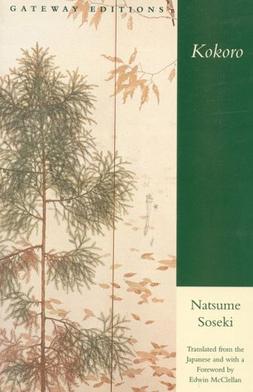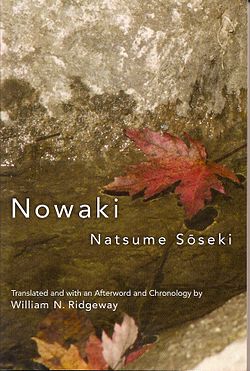
Torahiko Terada was a Japanese physicist and author who was born in Tokyo. He was a professor at Tokyo Imperial University, a researcher at RIKEN, and worked on a wide range of topics in physics. He was also a professor at the Earthquake Research Institute.

Natsume Sōseki, pen name Sōseki, born Natsume Kin'nosuke, was a Japanese novelist. He is best known for his novels Kokoro, Botchan, I Am a Cat, Kusamakura and his unfinished work Light and Darkness. He was also a scholar of British literature and writer of haiku, kanshi poetry and fairy tales.

Kokoro is a 1914 Japanese novel by Natsume Sōseki, and the final part of a trilogy starting with To the Spring Equinox and Beyond and followed by The Wayfarer. Set in the Meiji era, the novel tells of the acquaintance between a young man and an older man called "Sensei", who holds a secret from his past regarding the death of a friend.

James Murdoch was a Scottish Orientalist scholar and journalist, who worked as a teacher in the Empire of Japan and Australia. From 1903 to 1917, he wrote his "monumental" three-volume A History of Japan, the first comprehensive history of Japan in the English language. In 1917 he began teaching Japanese at the University of Sydney and in 1918 he was appointed the foundation professor of the School of Oriental Studies there.

Masao Kume was a Japanese popular playwright, novelist and haiku poet active during the late Taishō and early Shōwa periods of Japan. His wife and the wife of Nagai Tatsuo were sisters, making them brothers-in-law.
Kang Sang-jung, also known by his Japanese name Nagano Tetsuo (永野鉄男), is a Japanese-born South Korean political scientist, writer and public commentator. He has been an academic at several Japanese universities including the University of Tokyo (1996–2013), and President of Seigakuin University (2013–2015). He is currently Chairman of the Board of Kumamoto Prefectural Theatre.
Jay Rubin is an American translator, writer, scholar and Japanologist. He is one of the main translators of the works of the Japanese novelist Haruki Murakami into English. He has also written a guide to Japanese, Making Sense of Japanese, and a biographical literary analysis of Murakami.

Edwin McClellan was a British Japanologist, teacher, writer, translator and interpreter of Japanese literature and culture.

The Gate is a 1910 Japanese novel by Natsume Sōseki. It is the final part of a trilogy, preceded by Sanshirō (1908) and Sorekara (1909). The story follows Sosuke, who betrayed his best friend Yasui by marrying his wife Oyone, and how he seeks salvation from his guilt.

Kumamoto is the capital city of Kumamoto Prefecture on the island of Kyushu, Japan. As of June 1, 2019, the city has an estimated population of 738,907 and a population density of 1,893 people per km2. The total area is 390.32 km2.

The Wayfarer is a 1912 novel by Japanese writer Natsume Sōseki. It is the second part of a trilogy starting with To the Spring Equinox and Beyond (1912) and ending with Kokoro (1914).

Morita Yonematsu, known under pen name Morita Sōhei, was a novelist and translator of Western literature active during the late Meiji, Taishō and early Shōwa periods of Japan.
Yoshiko is a feminine Japanese given name.

Asai Chū was a Japanese painter, noted for his pioneering work in developing the yōga (Western-style) art movement in late 19th century and early twentieth-century Japanese painting.

Grass on the Wayside is a 1915 Japanese autobiographical novel by Sōseki Natsume. It is his only autobiographical work of fiction, and his last completed work. Together with Kokoro (1914), Grass on the Wayside is often cited as Natsume's major literary effort.

Light and Darkness or Light and Dark is a 1916 Japanese novel by Natsume Sōseki. It was his last novel and unfinished at the time of his death.
And Then is a 1909 Japanese novel by Natsume Sōseki. It is the second part of a trilogy, preceded by Sanshirō (1908) and followed by The Gate (1910).

Ehime Prefectural Matsuyama Higashi High School is a Japanese high school in Matsuyama, Ehime founded in 1878 as Matsuyama Middle School.

Nowaki is a short Japanese novel by Natsume Sōseki (1867–1916). Written in 1907, the novel was published in the magazine Hototogisu in January. The year 1907 was a turning point in the author's life when he left his Tokyo University teaching position to write full-time for the daily Asahi Shimbun. He also serialized the novel Gubijinsō (虞美人草) the same year.

Higashi-Saigawa-Sanshirō Station is a passenger railway station located in the town of Miyako, Fukuoka Prefecture, Japan. It is operated by the third-sector railway operator Heisei Chikuhō Railway. The station name pays tribute to Toyotaka Komiya, a Japanese literary critic and student of writer Natsume Sōseki. Born in Miyako, Komiya is known as the model for the character of Sanshirō in Sōseki's novel of the same name.















